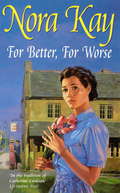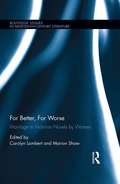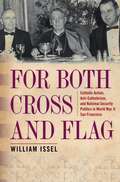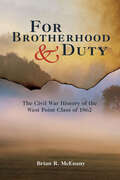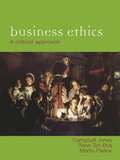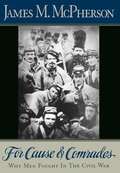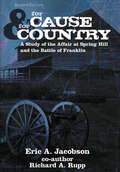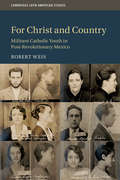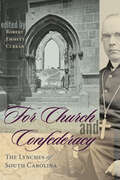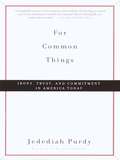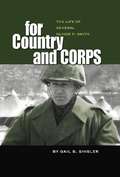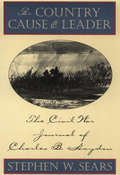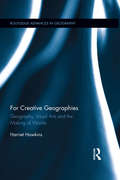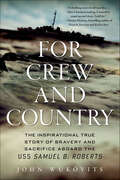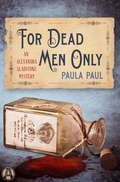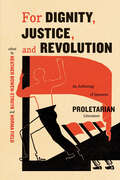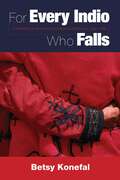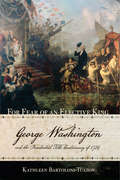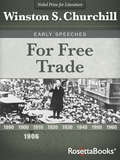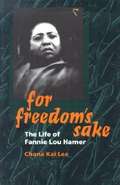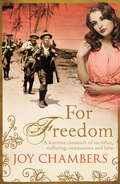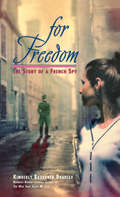- Table View
- List View
For Better, For Worse
by Nora KayJenny Richardson believes that marriage is for ever. Her life centres around her husband Paul, her daughters - fifteen-year-old Wilma and ten-year-old Katy - and their Perthshire home. Then one day Paul destroys it all. He has fallen in love with glamorous Vera Cuthbertson, and nothing will ever be the same again. When Jenny sets out to find a job, armed with more flattering clothes and a more attractive hair style, she finds not only a job but also admirers. But part of her still yearns for the certainties of her old life. A time will come when she will have to decide whether to go back or to strike out in an entirely new direction.
For Better, For Worse
by Nora KayJenny Richardson believes that marriage is for ever. Her life centres around her husband Paul, her daughters - fifteen-year-old Wilma and ten-year-old Katy - and their Perthshire home. Then one day Paul destroys it all. He has fallen in love with glamorous Vera Cuthbertson, and nothing will ever be the same again. When Jenny sets out to find a job, armed with more flattering clothes and a more attractive hair style, she finds not only a job but also admirers. But part of her still yearns for the certainties of her old life. A time will come when she will have to decide whether to go back or to strike out in an entirely new direction.
For Better, For Worse: Marriage in Victorian Novels by Women (Routledge Studies in Nineteenth Century Literature)
by Marion Shaw Carolyn LambertThis interdisciplinary volume explores the fictional portrayal of marriage by women novelists between 1800 and 1900. It investigates the ways in which these novelists used the cultural form of the novel to engage with and contribute to the wider debates of the period around the fundamental cultural and social building block of marriage. The collection provides an important contribution to the emerging scholarly interest in nineteenth-century marriage, gender studies, and domesticity, opening up new possibilities for uncovering submerged, marginalized, and alternative stories in Victorian literature. An initial chapter outlines the public discourses around marriage in the nineteenth century, the legal reforms that were achieved as a result of public pressure, and the ways in which these laws and economic concerns impacted on the marital relationship. It beds the collection down in current critical thinking and draws on life writing, journalism, and conduct books to widen our understanding of how women responded to the ideological and cultural construct of marriage. Further chapters examine a range of texts by lesser-known writers as well as canonical authors structured around a timeline of the major legal reforms that impacted on marriage. This structure provides a clear framework for the collection, locating it firmly within contemporary debate and foregrounding female voices. An afterword reflects back on the topic of marriage in the nineteenth- century and considers how the activism of the period influenced and shaped reform post-1900. This volume will make an important contribution to scholarship on Victorian Literature, Gender Studies, Cultural Studies, and the Nineteenth Century.
For Bitter or Worse
by Janet DaileyStacy tries to cope with running a ranch and helping her husband, cord deal with trying to walk again after a plane accident.
For Both Cross and Flag: Catholic Action, Anti-Catholicism, and National Security Politics in World War II San Francisco
by William IsselIn this fascinating, detailed history, William Issel recounts the civil right abuses suffered by Sylvester Andriano, an Italian American Catholic civil leader whose religious and political activism in San Francisco provoked an Anti-Catholic campaign against him. A leading figure in the Catholic Action movement, Andriano was falsely accused in state and federal Un-American Activities Committee hearings of having Fascist sympathies prior to and during World War II. As his ordeal began, Andriano was subjected to a hostile investigation by the FBI, whose confidential informants were his political rivals. Furthermore, the U. S. Army ordered him to be relocated on the grounds that he was a security risk. For Both Cross and Flagprovides a dramatic illustration of what can happen when parties to urban political rivalries, rooted in religious and ideological differences, seize the opportunity provided by a wartime national security emergency to demonize their enemy as 'a potentially dangerous person. ' Issel presents a cast of characters that includes archbishops, radicals, the Kremlin, J. Edgar Hoover, and more to examine the significant role faith-based political activism played in the political culture that violated Andriano's constitutional rights. Exploring the ramifications of this story,For Both Cross and Flagpresents interesting implications for contemporary events and issues relating to urban politics, ethnic groups, and religion in a time of war.
For Brotherhood & Duty: The Civil War History of the West Point Class of 1862 (American Warriors Ser.)
by Brian R. McEnanyDuring the tense months leading up to the American Civil War, the cadets at the United States Military Academy at West Point continued their education even as the nation threatened to dissolve around them. Students from both the North and South struggled
For Business Ethics
by Martin Parker Campbell Jones Rene ten BosFor Business Ethics is a daring adventure into the world of business ethics. It offers a clear and accessible introduction to business ethics and also expands business ethics beyond its current narrow confines. It is ground-breaking in the sense that it invites a distinctively critical approach to business ethics, an approach that the authors argue is part and parcel of ethics. With a thought-provoking glossary and recommendations for further readings, For Business Ethics is an essential purchase for students and practitioners alike. It is at once an introduction to business ethics and a challenge to anyone who wishes to take part in or change contemporary organized society.
For Cause and Comrades: Why Men Fought in the Civil War
by James M. McphersonWhy did the soldiers of the Civil War--Confederate and Union--risk their lives, through countless bloody battles and four long, awful years? Drawing on more than 25,000 uncensored letters and nearly 250 private diaries from men on both sides, James McPherson shows that the soldiers of the Civil War remained powerfully convinced of the ideals for which they fought throughout the conflict. Motivated by duty and honor, and often by religious faith, these men wrote frequently of their firm belief in the cause for which they went to war: the principles of liberty, freedom, justice, and patriotism. For Cause and Comrades lets these soldiers tell their stories in their own word to create an account that is both deeply moving and far truer than most books of war. McPherson's masterful prose and the soldiers' words combine to create both an important book on an often overlooked aspect of our bloody Civil War, and a powerfully moving account of the men who fought it. "In a prose that is both sensitive and remarkably lucid, [McPherson] helps us re-enter an American society in which ideals were not merely pat phrases but principles that inspired conduct--however hateful some of those principles were." --New York Review of Hook James McPherson is the George Henry Davis '86 Professor of American history at Princeton University where he has taught since 1962. The author of eleven books on the Civil War era, he won the Pulitzer Prize in History in 1989 for Battle Cry of Freedom.
For Cause and Country: A Study of the Affair at Spring Hill and the Battle of Franklin
by Eric A. Jacobson Richard A Rupp“An up-to-date, accurate, comprehensive and lively treatment of . . . arguably one of the bloodiest five hours during the American Civil War.” —The Civil War GazetteThe battles at Spring Hill and Franklin, Tennessee, in the late autumn of 1864 were watershed moments in the American Civil War. Thousands of hardened veterans and a number of recruits, as well as former West Point classmates, found themselves moving through Middle Tennessee in the last great campaign of a long and bitter war. Replete with bravery, dedication, bloodshed, and controversy, these battles led directly to the conclusion of action in the Western Theater. Spring Hill and Franklin, which were once long ignored and seldom understood, have slowly been regaining their place on the national stage. They remain one of the most compelling episodes of the Civil War. Through exhaustive research and the use of sources never before published, the stories of both battles come vividly to life in For Cause & For Country. Over 100 pages of material have been added to this new edition, including new maps and photos. The genesis and early stages of the Tennessee Campaign play out in clear and readable fashion. The lost opportunity at Spring Hill is evaluated in great detail, and the truth of what happened there is finally shown based on evidence rather than conjecture. The intricate dynamics of the Confederate high command, and especially the roles of General John Bell Hood and General Frank Cheatham, are given special attention. For Cause & For Country is “a highly complex but skillfully organized, easy-to-follow campaign narrative written in stirring fashion” (Civil War Books and Authors).
For Christ and Country: Militant Catholic Youth in Post-Revolutionary Mexico (Cambridge Latin American Studies #115)
by Robert WeisWhy did José de León Toral kill Álvaro Obregón, leader of the Mexican Revolution? So far, historians have characterized the motivations of the young Catholic militant as the fruit of fanaticism. This book offers new insights on how diverse sectors experienced the aftermath of the Revolution by exploring the religious, political, and cultural contentions of the 1920s. Far from an isolated fanatic, León Toral represented a generation of Mexicans who believed that the revolution had unleashed ancient barbarism, sinful consumerism, and anticlerical tyranny. Facing attacks against the Catholic essence of Mexican nationalism, they emphasized asceticism, sacrifice, and the redemptive potential of violence. Their reckless enthusiasm to launch assaults was a sign of their devotion. León Toral insisted that 'only God' was his accomplice; in fact, he was cheered by thousands who dreamed of bringing the Kingdom of Christ to beleaguered Mexico.
For Church and Confederacy: The Lynches of South Carolina
by Robert Emmett CurranThrough letters and other writings, this historical study chronicles an Irish Catholic family’s influence on mid-nineteenth–century South Carolina.For Church and Confederacy unveils the lives of the Lynch family during the late antebellum and Civil War years. Settling in the South Carolina upcountry, Irish immigrants Conlaw and Eleanor Lynch imparted their ambitions to their children, several of whom would make exceptional marks in such areas as education, manufacturing, and religious life.Patrick Lynch, the third Roman Catholic bishop of Charleston, developed a national reputation as a polemicist, and during the Civil War he was appointed as a Confederate special commissioner to the Papal States. Other family members, particularly Francis, whose tanneries supplied shoes to thousands of soldiers, and Ellen, whose Catholic academy became a refuge for the children of prominent Southern families, also made valuable contributions to the Confederacy. All of them considered slaveholding indispensable to achieving their position in Southern society. Though the Lynches were on the periphery of the political turmoil that led to disunion, they became strong secessionists once the war began. By the war’s end most found themselves in the path of William T. Sherman’s avenging army and suffered great losses. Featuring meticulous notes and commentary placing the Lynch siblings’ writings in historical context, this compelling portrait of the complex relationship among religion, slavery, and war has a sweep that carries the reader along as the war gradually overtakes the family’s privileged world and eventually brings it down.
For Common Things: Irony, Trust, and Commitment in America Today
by Jedediah PurdyJedediah Purdy calls For Common Things his "letter of love for the world's possibilities." Indeed, these pages--which have already garnered a flurry of attention among readers and in the media--constitute a passionate and persuasive testament to the value of political, social, and community reengagement. Drawing on a wide range of literary and cultural influences--from the writings of Montaigne and Thoreau to the recent popularity of empty entertainment and breathless chroniclers of the technological age--Purdy raises potent questions about our stewardship of civic values.Most important, Purdy offers us an engaging, honest, and bracing reminder of what is crucial to the healing and betterment of society, and impels us to consider all that we hold in common.From the Trade Paperback edition.
For Country and Corps
by Gail B. ShislerOliver P. Smith fought at Peleliu and Okinawa and then commanded the 1st Marine Division in Korea during the assault at Inchon, the recapture of Seoul, and the breakout from the Chosin Reservoir. Called one of the twentieth century's great Marine leaders, Smith was known as an outstanding combat commander and a man of great intellect and moral courage. This biography, written by the granddaughter he helped raise, illuminates the general's remarkable life. It draws on interviews, oral histories and a thorough examination of letters held by the family and not previously available to researchers. Gail Shisler's investigation of Smith's relationship with his Army superiors in Korea and with his Marine Corps peers and superiors takes exception to previously published descriptions and adds new insights into the Corps' postwar battle for survival.
For Country, Cause & Leader: The Civil War Journal of Charles B. Haydon
by Stephen W. SearsNow published for the first time, an eyewitness account of the Civil War by a Union soldier who fought from Bull Run to Knoxville.This remarkable book presents the transcription of some twenty pocket diaries kept throughout the first three years of the Civil War by Charles B. Haydon and sent back one by one to his home in Decatur, Michigan, to be read by his father and brother. As readable as they are lively and informative, they offer a marvelous firsthand view of the war and constitute an important addition to our Civil War library.Haydon began as a third sergeant and ended as a lieutenant colonel. In the East he witnessed the rush to the colors, the first Bull Run, the building of the Army of the Potomac, the Peninsula campaign, and the fighting at second Bull Run and Fredericksburg. Early in 1863 his regiment was transferred to the western theater, where it served in Kentucky and under Grant at Vicksburg. Haydon was severely wounded in Mississippi. During the winter of 1863-64 he was in Tennessee and engaged in the campaigning around Knoxville. In March 1864—ironically, on his way home on furlough—Haydon contracted pneumonia and died.Charles Haydon had considerably more education than the average soldier, and his “engaging” journal reflects the fact (Publishers Weekly). A good half-dozen years older than most of his fellow recruits, he had studied for four years at the University of Michigan, read law, and was in practice when he volunteered. His journal, which was meant to be read, was a deliberate and conscientious attempt to record his experiences and thoughts of the war.
For Creative Geographies: Geography, Visual Arts and the Making of Worlds (Routledge Advances in Geography)
by Harriet HawkinsThis book provides the first sustained critical exploration, and celebration, of the relationship between Geography and the contemporary Visual Arts. With the growth of research in the Geohumanities and the Spatial Humanities, there is an imperative to extend and deepen considerations of the form and import of geography-art relations. Such reflections are increasingly important as geography-art intersections come to encompass not only relationships built through interpretation, but also those built through shared practices, wherein geographers work as and with artists, curators and other creative practitioners. For Creative Geographies features seven diverse case studies of artists’ works and exhibitions made towards the end of the twentieth and the beginning of the twentieth-first century. Organized into three analytic sections, the volume explores the role of art in the making of geographical knowledge; the growth of geographical perspectives as art world analytics; and shared explorations of the territory of the body, In doing so, Hawkins proposes an analytic framework for exploring questions of the geographical “work” art does, the value of geographical analytics in exploring the production and consumption of art, and the different forms of encounter that artworks develop, whether this be with their audiences, or their makers.
For Crew and Country: The Inspirational True Story of Bravery and Sacrifice Aboard the USS Samuel B. Roberts
by John WukovitsThe acclaimed WWII historian recounts the most dramatic naval battle of the Pacific War and the incredible sacrifice of the USS Samuel B. Roberts.On October 25, 1944, the Samuel B. Roberts, along with the other twelve vessels comprising its unit, stood between Japan’s largest battleship force ever sent to sea and MacArthur’s transports inside Leyte Gulf. Faced with the surprise appearance of more than twenty Japanese battleships, cruisers, and destroyers—including the infamous Yamato—the Samuel B. Roberts turned immediately into action with six other ships.Captain Copeland marked the occasion with one of the most poignant addresses ever given to men on the edge of battle: “Men,” he said over the intercom, “we are about to go into a fight against overwhelming odds from which survival cannot be expected.”The Samuel B. Roberts went down with guns blazing in a duel reminiscent of Davy Crockett’s Alamo defenders. The men who survived faced a horrifying three-day nightmare in the sea, where they battled a lack of food and water, scorching sun, numbing nighttime cold, and bloodthirsty sharks. In For Crew and Country, John Wukovitz vividly chronicles the Battle off Samar, one of history’s greatest clashes at sea.
For Dead Men Only
by Paula PaulHailed as "an intriguing mixture of mystery, romance, and history" by Lois Duncan, the Alexandra Gladstone series from award-winning author Paula Paul continues as an ominous horseman heralds the emergence of a secret society, hidden riches--and a string of chilling murders. The Temple of the Ninth Daughter sits on a hill at the edge of Newton-upon-Sea, an aura of mystery lingering over its tall, gray silhouette. Villagers whisper about the treasure housed inside, protected by local Freemasons who are bound by clandestine oaths. Dr. Alexandra Gladstone has no time for such nonsense. Between the patients in her surgery and the rounds she makes with her faithful dog, Zack, her days are busy enough. But Alexandra has no logical explanation when the Freemasons start dying, one by one, with no sign of foul play other than smears of blood on their Masonic aprons. And what to make of reports that a Knight Templar rides through the village before each passing? After the constable disappears in the midst of the crisis, Alexandra reaches out to her dashing, diligent friend, Nicholas Forsythe, Lord Dunsford, for assistance. Is someone after the treasure, or might a more sinister game be afoot? In order to solve this puzzle, Alexandra must somehow catch a killer who shows no remorse--and leaves no witnesses. Praise for Paula Paul's Alexandra Gladstone mysteries "I love the way real personalities from the past keep popping up to intermingle with Paul's fictional characters."--Lois Duncan, award-winning and bestselling author of Killing Mr. Griffin and I Know What You Did Last Summer "A lively mixture of ruling-class murder, Victorian morals, and love."--Bestselling author Tony Hillerman "I would recommend this to fans of the Maisie Dobbs series. There's a strong female character in a historical setting. She's determined, logical, intelligent and faces an unusual situation."--The Reader's Hollow
For Dignity, Justice, and Revolution: An Anthology of Japanese Proletarian Literature
by Norma Field Heather Bowen-StruykFiction created by and for the working class emerged worldwide in the early twentieth century as a response to rapid modernization, dramatic inequality, and imperial expansion. In Japan, literary youth, men and women, sought to turn their imaginations and craft to tackling the ensuing injustices, with results that captured both middle-class and worker-farmer readers. This anthology is a landmark introduction to Japanese proletarian literature from that period. Contextualized by introductory essays, forty expertly translated stories touch on topics like perilous factories, predatory bosses, ethnic discrimination, and the myriad indignities of poverty. Together, they show how even intensely personal issues form a pattern of oppression. Fostering labor consciousness as part of an international leftist arts movement, these writers, lovers of literature, were also challenging the institution of modern literature itself. This anthology demonstrates the vitality of the "red decade" long buried in modern Japanese literary history.
For Every Indio Who Falls: A History of Maya Activism in Guatemala, 1960-1990
by Betsy KonefalIn 1978, a Maya community queen stood on a stage to protest a massacre of indigenous campesinos at the hands of the Guatemalan state. She spoke graphically to the dead and to the living alike: Brothers of Panzós, your blood is in our throats!Given the context, her message might come as a surprise. A revolutionary insurgency in the late 1970s was being met by brutal state efforts to defeat it, efforts directed not only at the guerrilla armies but also at reform movements of all kinds. Yet the young woman was just one of many Mayas across the highlands voicing demands for change. Over the course of the 1970s, Mayas argued for economic, cultural, and political justice for the indigenous pueblo. Many became radicalized by state violence against Maya communities that soon reached the level of genocide.Scholars have disagreed about Maya participation in Guatemala's civil war, and the development of oppositional activism by Mayas during the war is poorly understood. Betsy Konefal explores this history in detail, examining the roots and diversity of Maya organizing and its place in the unfolding conflict. She traces debates about ethnicity, class, and revolution, and examines how (some) Mayas became involved in opposition to a repressive state. She looks closely at the development of connections between cultural events like queen pageants and more radical demands for change, and follows the uneasy relationships that developed between Maya revolutionaries and their Ladino counterparts. Konefal makes it clear that activist Mayas were not bystanders in the transformations that preceded and accompanied Guatemala's civil war--activism by Mayas helped shape the war, and the war shaped Maya activism.
For Fear of an Elective King: George Washington and the Presidential Title Controversy of 1789
by Kathleen Bartoloni-TuazonIn the spring of 1789, within weeks of the establishment of the new federal government based on the U.S. Constitution, the Senate and House of Representatives fell into dispute regarding how to address the president. Congress, the press, and individuals debated more than a dozen titles, many of which had royal associations and some of which were clearly monarchical. For Fear of an Elective King is Kathleen Bartoloni-Tuazon's rich account of the title controversy and its meanings. The short, intense legislative phase and the prolonged, equally intense public phase animated and shaped the new nation’s broadening political community. Rather than simply reflecting an obsession with etiquette, the question challenged Americans to find an acceptable balance between power and the people’s sovereignty while assuring the country’s place in the Atlantic world. Bartoloni-Tuazon argues that the resolution of the controversy in favor of the modest title of "President" established the importance of recognition of the people's views by the president and evidence of modesty in the presidency, an approach to leadership that fledged the presidency’s power by not flaunting it. How the country titled the president reflected the views of everyday people, as well as the recognition by social and political elites of the irony that authority rested with acquiescence to egalitarian principles. The controversy’s outcome affirmed the republican character of the country’s new president and government, even as the conflict was the opening volley in increasingly partisan struggles over executive power. As such, the dispute is as relevant today as in 1789.
For Free Trade (Winston S. Churchill Early Speeches)
by Winston S. ChurchillThis collection of speeches in support of free trade by the future Prime Minister tracks his early rise in British Parliament. Throughout his career—as both a Conservative and a Liberal—Winston Churchill was a strong supporter of free trade. As a Conservative, this position was sometimes controversial; early in his career, Churchill opposed Joseph Chamberlain's strategy of imposing tariffs to protect Britain&’s economic dominance. When he defected to the Liberal Party in 1904, Churchill continued to be a fierce free trade advocate. Originally published in 1906, For Free Trade was an influential political pamphlet that made Churchill&’s speeches on the subject available to the British people. This collection contains speeches delivered in Manchester or The House of Commons between 1902 and 1905.
For Freedom's Sake: The Life of Fannie Lou Hamer
by Chana Kai LeeA biography of Fannie Lou Hamer, one of the most important civil rights activists of the 20th century. It documents Hamer's lifelong crusade to empower the poor through collective action and the personal costs of her struggle to win a political voice and economic self-sufficiency for blacks in the segregated South.
For Freedom: A wartime saga of bravery, compassion and love
by Joy ChambersFor Freedom is a tangled and dramatic story of two couples in love and war, set in the Philippines during the World War II. The perfect read for fans of Margaret Leroy and Patricia Shaw. 'There's action and passion galore in Joy Chambers' For Freedom' - Australian Women's Weekly December 1941. The whole of South East Asia appears to be capitulating before the rising sun and four remarkable people are about to reassess their lives: Lexi Robinson: the doctor with a secret from the past who escapes before Hong Kong is invaded, only to find herself still within the enemy net. John Drayton Whitby: Australian army officer who focuses on the long, harrowing fight for freedom even whilst his mind clouds with suspicions about his wife. Hank 'Trap' Trapperton: the West Point-trained American 'spy' who is John Drayton's trusted friend and yet not really his friend at all. And Kathleen Leigh: the woman brought up to believe a lie until the day comes when she must confront the appalling truth.What people are saying about For Freedom:'A wonderful author and a wonderful book''Joy Chambers is up there with the very best authors and meticulously researches her book subjects''For Freedom is something else. It is informative, educational, entertaining and totally engrossing'
For Freedom: A wartime saga of bravery, compassion and love
by Joy ChambersFor Freedom is a tangled and dramatic story of two couples in love and war, set in the Philippines during the World War II. The perfect read for fans of Margaret Leroy and Patricia Shaw. 'There's action and passion galore in Joy Chambers' For Freedom' - Australian Women's Weekly December 1941. The whole of South East Asia appears to be capitulating before the rising sun and four remarkable people are about to reassess their lives: Lexi Robinson: the doctor with a secret from the past who escapes before Hong Kong is invaded, only to find herself still within the enemy net. John Drayton Whitby: Australian army officer who focuses on the long, harrowing fight for freedom even whilst his mind clouds with suspicions about his wife. Hank 'Trap' Trapperton: the West Point-trained American 'spy' who is John Drayton's trusted friend and yet not really his friend at all. And Kathleen Leigh: the woman brought up to believe a lie until the day comes when she must confront the appalling truth.What people are saying about For Freedom:'A wonderful author and a wonderful book''Joy Chambers is up there with the very best authors and meticulously researches her book subjects''For Freedom is something else. It is informative, educational, entertaining and totally engrossing'
For Freedom: The Story Of A French Spy
by Kimberly Brubaker BradleyA teenager transforms from a schoolgirl to a spy in this true story of heroism in wartime. Suzanne David's everyday life is suddenly shattered in 1940 when a bomb drops on the main square of her hometown, the city of Cherbourg, France, killing a pregnant neighbor right in front of her. Until then the war had seemed far away, not something that would touch her or her teenage friends. Now Suzanne's family is kicked out onto the street as German soldiers take over their house as a barracks. Suzanne clings to the one thing she really loves--singing. Her voice is so amazing that she is training to become an opera singer. As Suzanne travels around for rehearsals, cosume fittings, or lessons, she learns more about what the Nazis are doing and about the people who are "disappearing." Her travels are noticed by someone else, an organizer of the French Resistance. Soon Suzanne is a secret courier, a spy fighting for France and risking her own life for freedom.
